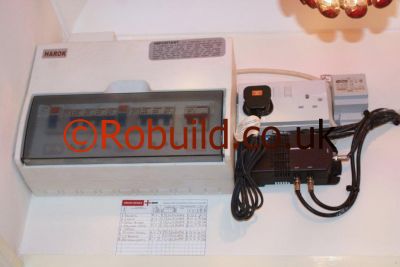When electric current passes through a wire it causes heating: the thinner the wire the greater the heat. Even the thick wire used in domestic wiring will overheat if too much current passes through it and may easily set the house on fire. To prevent this, a fuse is built into every circuit. This is a particularly thin piece of wire which will heat up quickly and melt if a more than safe quantity of current passes through it.

Modern fuse box – Consumer Unit
Types of fuses
All master fuses one for each circuit are mounted on fuse carriers in a fuse box close to the Electricity Board’s supply meter. There are two main types, rewirable and cartridge, although miniature circuit breakers are sometimes flitted instead of fuses.
Rewirable
This type has fuse wire stretched between two retaining screws on the porcelain or plastic fuse carrier. The wire is available in three ratings – 5, 15 and 30amp and you can usually buy a card of wire carrying a supply of all three.
Cartridge
This type cannot be rewired since the fuse is sealed inside a tube; once it blows the fuse must be replaced. The advantage of the master cartridge fuse is it is impossible to fit the wrong one because each rating has a different size cartridge (as compared to plug fuses that are uniform in size). The fuses are also colour coded so they can be easily recognized: 5amp is white, 15amp blue, 20amp yellow, 30amp red and 45amp green.
Miniature circuit breakers
Used in domestic fuse boxes instead of fuses, these automatically switch themselves off if a circuit is overloaded. When the fault has been corrected the circuit can be reconnected just by resetting the on/off switch.
Why fuses blow
A master fuse will blow if the circuit is overloaded, if the fuse wire is of too low a rating or if a faulty appliance is used with an unfused plug or socket. Before repairing the fuse check you are not using too many appliances on one circuit and make sure you are using the right size fuse for the circuit. If you suspect a faulty appliance, even though it seems to be working adequately, stop using it and call an electrician or contact the manufacturer. Sometimes a fuse blows simply because it is o1d; all you need to do is replace it with a new one of the correct rating. If a fuse still blows alter being replaced, call an electrician.
Don’t try to stop a fuse blowing by putting in a higher rated one.
Tracing faults
If one of your lights goes out see first whether those nearby are still working; if they are it is likely only the lamp bulb has blown. If all your lights are out check whether the street or your neighbours are in darkness too; if they are there is nothing wrong with your fuses – there is a general power failure and you will just have to wait for the power to be restored. If everyone else’s lights are working you have an internal power failure, so turn off the relevant switch before investigating. You will save time and trouble by keeping a small electrical screwdriver, a torch and replacement fuses or fuse wire handy by the fuse box. A supply of candles in the house is also good sense.
Rewiring fuses
Always turn off the mains supply switch before attempting any repairs. If you are really efficient you will have made a numbered plan of the carriers in your fuse box, labelling each one according to the circuit it controls (cooker, downstairs sockets,upstairs lights etc.). This plan should be taped on the inside of the fuse box door so, when investigating a blown fuse, you can pick out the relevant Cartridge fuses carrier first time.
If you have not labelled them you must pull out each carrier in turn to find the blown fuse – look for one which has a broken or melted fuse wire. Undo the screws which clamp the fuse wire in place and remove the remains of the old wire. Stretch a new wire of the correct rating loosely between the screws and wind the ends in a clockwise direction round the screws, which must be carefully tightened until the wire is firmly held. Replace the fuse holder and close the fuse box before reconnecting the supply.
Replacing cartridge fuses
The only way of telling which cartridge fuse has blown is to remove one carrier at a time. Turn off the mains switch, remove a carrier, close the fuse box cover and switch on the mains supply. If everything else continues to work you have found the failed fuse. Take out the cartridge and replace it with a new one of the correct rating, refit the fuse carrier, close the box cover and turn on the main switch.


